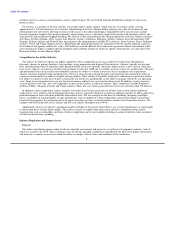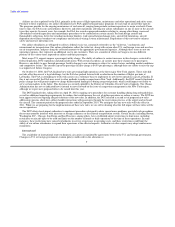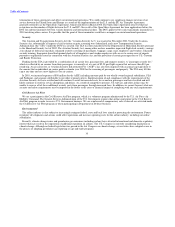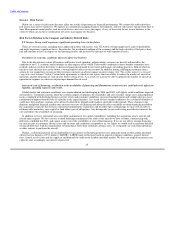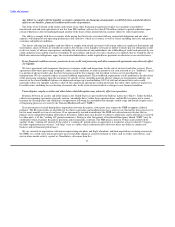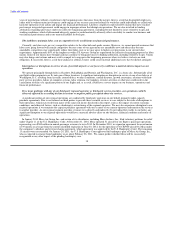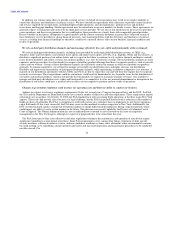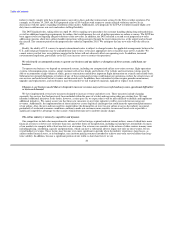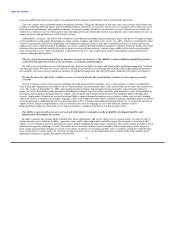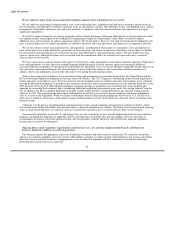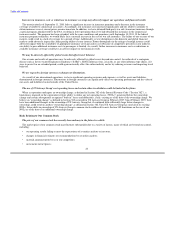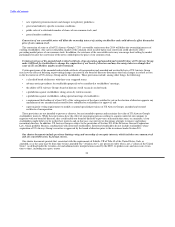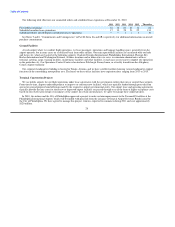US Airways 2010 Annual Report Download - page 19
Download and view the complete annual report
Please find page 19 of the 2010 US Airways annual report below. You can navigate through the pages in the report by either clicking on the pages listed below, or by using the keyword search tool below to find specific information within the annual report.
Table of Contents
years of negotiations without a resolution to the bargaining issues that arose from the merger, there is a risk that disgruntled employees,
either with or without union involvement, could engage in one or more concerted refusals to work that could individually or collectively
harm the operation of our airline and impair our financial performance. Likewise, employees represented by unions that have reached
post-merger integrated agreements could engage in improper actions that disrupt our operations. We are also involved in binding
arbitrations regarding grievances under our collective bargaining agreements, including but not limited to issues related to wages and
working conditions, which if determined adversely against us could materially adversely affect our ability to conduct our business and
our financial performance and create material liability for back pay.
The inability to maintain labor costs at competitive levels would harm our financial performance.
Currently, our labor costs are very competitive relative to the other hub-and-spoke carriers. However, we cannot provide assurance that
labor costs going forward will remain competitive because some of our agreements are amendable now and others may become
amendable, competitors may significantly reduce their labor costs or we may agree to higher-cost provisions in our current labor
negotiations. Approximately 86% of the employees within US Airways Group are represented for collective bargaining purposes by labor
unions. Some of our unions have brought and may continue to bring grievances to binding arbitration, including related to wages. Unions
may also bring court actions and may seek to compel us to engage in the bargaining processes where we believe we have no such
obligation. If successful, there is a risk these judicial or arbitral avenues could create material additional costs that we did not anticipate.
Interruptions or disruptions in service at one of our hub airports or our focus city could have a material adverse impact on our
operations.
We operate principally through hubs in Charlotte, Philadelphia and Phoenix and Washington, D.C. is a focus city. Substantially all of
our flights either originate in or fly into one of these locations. A significant interruption or disruption in service at one of our hubs or at
Washington, D.C. resulting from air traffic control delays, weather conditions, natural disasters, growth constraints, relations with third-
party service providers, failure of computer systems, labor relations, fuel supplies, terrorist activities or otherwise could result in the
cancellation or delay of a significant portion of our flights and, as a result, could have a severe impact on our business, operations and
financial performance.
If we incur problems with any of our third-party regional operators or third-party service providers, our operations could be
adversely affected by a resulting decline in revenue or negative public perception about our services.
A significant portion of our regional operations are conducted by third-party operators on our behalf, primarily under capacity
purchase agreements. Due to our reliance on third parties to provide these essential services, we are subject to the risks of disruptions to
their operations, which may result from many of the same risk factors disclosed in this report, such as the impact of current economic
conditions, and other risk factors, such as a bankruptcy restructuring of the regional operators. We may also experience disruption to our
regional operations if we terminate the capacity purchase agreement with one or more of our current operators and transition the services
to another provider. As our regional segment provides revenues to us directly and indirectly (by providing flow traffic to our hubs), any
significant disruption to our regional operations would have a material adverse effect on our business, financial condition and results of
operations.
In January 2010, Mesa Air Group, Inc. and certain of its subsidiaries, including Mesa Airlines, Inc., filed voluntary petitions for relief
under Chapter 11 of the U.S. Bankruptcy Code. At December 31, 2010, Mesa operated 51 aircraft for our Express passenger operations,
representing over $500 million in annual passenger revenues to us in 2010. In November 2010, we signed an agreement for an extension
of 39 months on average from the current scheduled expiration of June 30, 2012, for the operation of 38 CRJ900 aircraft by Mesa under
the companies' codeshare and revenue sharing agreement, which agreement was approved by the U.S. Bankruptcy Court. The remaining
13 aircraft were not extended. On January 20, 2011, the U.S. Bankruptcy Court approved the bankruptcy plan of Mesa Air Group, Inc.,
who is expected to emerge from bankruptcy on or about February 28, 2011. We cannot predict whether Mesa will be successfully
reorganized or any other aspect of the pending bankruptcy case.
18


